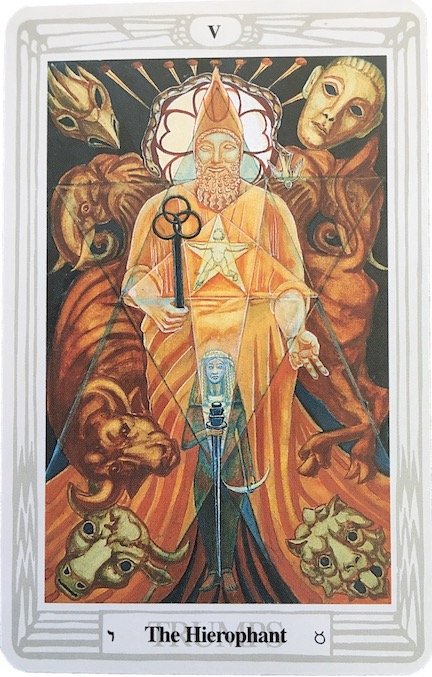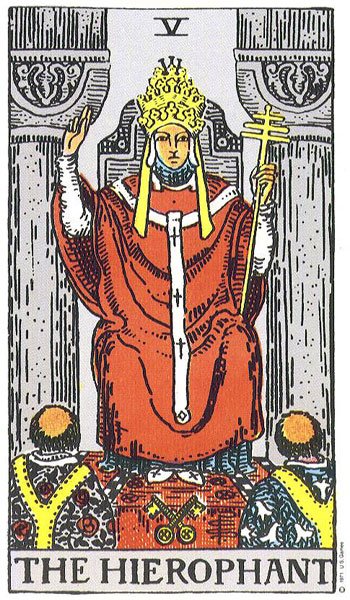THE HIEROPHANT : KEY V
Zodiacal Trump of Taurus
Venus Rules
Luna Exalted
Hebrew Letter: Vau (Nail)
Path 16 joining
Sphere 2-Wisdom and 4-Mercy
Offer thyself Virgin to the Knowledge and Conversation of thine Holy Guardian Angel! All else is a snare.
Be thou athlete with the eight limbs of Yoga: for without these thou are not disciplined for any fight.
Stubborn strength, toil, endurance, placidity, manifestation, explanation, teaching, goodness of heart, help from superiors, patience, organization, peace.
Alesiter Crowley
The Book of Thoth
This card is referred to the letter Vau, which means a Nail; of this instrument nine appear at the top of the card; they serve to fix the oriel behind the main figure of the picture.
The card is referred to Taurus; therefore the Throne of the Hierophant is surrounded by elephants, which are the nature of Taurus; and he is actually seated upon a bull. Around him are the four beasts or Kerubs, one in each corner of the card; for these are the guardians of every shrine. But the main reference is to the particular arcanum which is the principal business, the essential, of all magical work; the uniting of the microcosm with the macrocosm.
Wisdom to each apportioned to his want By modes of Light, shed forth, great Hierophant!
Accordingly, the oriel is diaphanous; before the Manifestor of the Mystery is a hexagram representing the macrocosm. In its centre is a pentagram, representing a dancing male child. This symbolizes the law of the new Aeon of the Child Horus, which has supplanted that Aeon of the “Dying God” which governed the world for two thousand years. Before him is the woman girt with a sword; she represents the Scarlet Woman in the hierarchy of the new Aeon. This symbolism is further carried out in the oriel where, behind the phallic headdress, the rose of five petals is in blossom.
The symbolism of the snake and dove refers to this verse of the Book of the Law—- chap. I, verse 57; “there are love and love. There is the dove, and there is the serpent”.
This symbol recurs in the trump numbered XVI.
The background of the whole card is the dark blue of the starry night of Nuit, from whose womb all phenomena are born.
Taurus, the sign of the Zodiac represented by this card, is itself the Bull Kerub; that is, Earth in its strongest and most balanced form.
The ruler of this sign is Venus; she is represented by the woman standing before the hierophant.
Chapter III of the Book of the Law, verse xi, reads: “Let the woman be girt with a sword before me.” This woman represents Venus as she now is in the new aeon; no longer the mere vehicle of her male counterpart, but armed and militant.
In this sign the Moon is “exalted”; her influence is represented not only by the woman, but by the nine nails.
It is impossible at the present time to explain this card thoroughly, for only the course of events can show how the new current of initiation will work out.
It is the aeon of Horus, of the Child. Though the face of the Hierophant appears benignant and smiling, and the child himself seems glad with wanton innocence, it is hard to deny that in the expression of the initiator is something mysterious, even sinister. He seems to be enjoying a very secret joke at somebody’s expense. There is a distinctly sadistic aspect to this card; not unnaturally, since it derives from the Legend of Pasiphae, the prototype of all the legends of Bull-gods. These still persist in such religions as Shaivism, and (after multiple degradations) in Christianity itself.
The symbolism of the Wand is peculiar; the three interlaced rings with crown it may be taken as representative of the three Aeons of Isis, Osiris and Horus with their interlocking magical formulae. The upper ring is marked with scarlet for Horus; the two lower rings with green for Isis, and pale yellow for Osiris, respectively. All these are based upon deep indigo, the color of Saturn, the Lord of Time. For the rhythm of the Hierophant is such that he moves on at intervals of 2,000 years.

Joan Bunning
Except in rare cases, every human grows and develops within a culture. We learn by living with others. The Hierophant represents such official learning, especially in groups. A Hierophant is someone who interprets secret knowledge. On Card 5 we see a religious figure in a formal church setting. He is wearing the elaborate vestments of his office. His task is to bring the two initiates into the church so they can take up their appointed roles.
Besides churches, there are schools, clubs, teams, companies, and societies. The Hierophant represents all of these because his realm is structured groups with rules and assigned roles. Such environments emphasize belief systems – facts, rules, procedures, and ritual. Members are rewarded for following conventions. They develop a group identity. The Hierophant is one of three cards that focuses on the group. (The 3 of Cups and the 3 of Pentacles are the others.)
In readings, the Hierophant often represents learning with experts or knowledgeable teachers. This card also stands for institutions and their values. The Hierophant is a symbol of the need to conform to rules or fixed situations. His appearance in a reading can show that you are struggling with a force that is not innovative, free-spirited or individual. Groups can be enriching or stifling, depending on circumstances. Sometimes we need to follow a program or embrace tradition, other times, we need to trust ourselves.
THE HIEROPHANT’S ACTIONS
GETTING AN EDUCATION
becoming informed
increasing understanding
studying and learning
seeking a deeper meaning
finding out more
HAVING A BELIEF SYSTEM
learning a religious tradition
honoring ritual and ceremony
identifying a world view
following a discipline
knowing where to put your faith
CONFORMING
taking an orthodox approach
staying within conventional bounds
adapting to the system
fitting in
going along with the program
doing what’s expected
being part of the Establishment
IDENTIFYING WITH A GROUP
devoting energy to a group
joining an organization
working as part of a team
feeling loyal to others
being in an institutionalized setting
THE HIEROPHANT’S ROLE IN THE FOOLS JOURNEY
Eventually, the Fool ventures out of his home into the wider world. He is exposed to the beliefs and traditions of his culture and begins his formal education. The Hierophant (5) represents the organized belief systems that begin to surround and inform the growing child.
A Hierophant is someone who interprets arcane knowledge and mysteries. On Card 5 we see a religious figure blessing two acolytes. Perhaps he is inducting them into church membership. Although this image is religious, it is really a symbol for initiations of all kinds.
The child is trained in all the practices of his society and becomes part of a particular culture and worldview. He learns to identify with a group and discovers a sense of belonging. He enjoys learning the customs of his society and showing how well he can conform to them.
A. E. Waite
The Pictorial Key to the Tarot
He wears the triple crown and is seated between two pillars, but they are not those of the Temple which is guarded by the High Priestess. In his left hand he holds a sceptre terminating in the triple cross, and with his right hand he gives the well-known ecclesiastical sign which is called that of esotericism, distinguishing between the manifest and concealed part of doctrine. It is noticeable in this connexion that the High Priestess makes no sign. At his feet are the crossed keys, and two priestly ministers in albs kneel before him. He has been usually called the Pope, which is a particular application of the more general office that he symbolizes. He is the ruling power of external religion, as the High Priestess is the prevailing genius of the esoteric, withdrawn power. The proper meanings of this card have suffered woeful admixture from nearly all hands. Grand Orient says truly that the Hierophant is the power of the keys, exoteric orthodox doctrine, and the outer side of the life which leads to the doctrine; but he is certainly not the prince of occult doctrine, as another commentator has suggested.
He is rather the summa totius theologiæ, when it has passed into the utmost rigidity of expression; but he symbolizes also all things that are righteous and sacred on the manifest side. As such, he is the channel of grace belonging to the world of institution as distinct from that of Nature, and he is the leader of salvation for the human race at large. He is the order and the head of the recognized hierarchy, which is the reflection of another and greater hierarchic order; but it may so happen that the pontiff forgets the significance of this his symbolic state and acts as if he contained within his proper measures all that his sign signifies or his symbol seeks to shew forth. He is not, as it has been thought, philosophy-except on the theological side; he is not inspiration; and he is not religion, although he is a mode of its expression.


